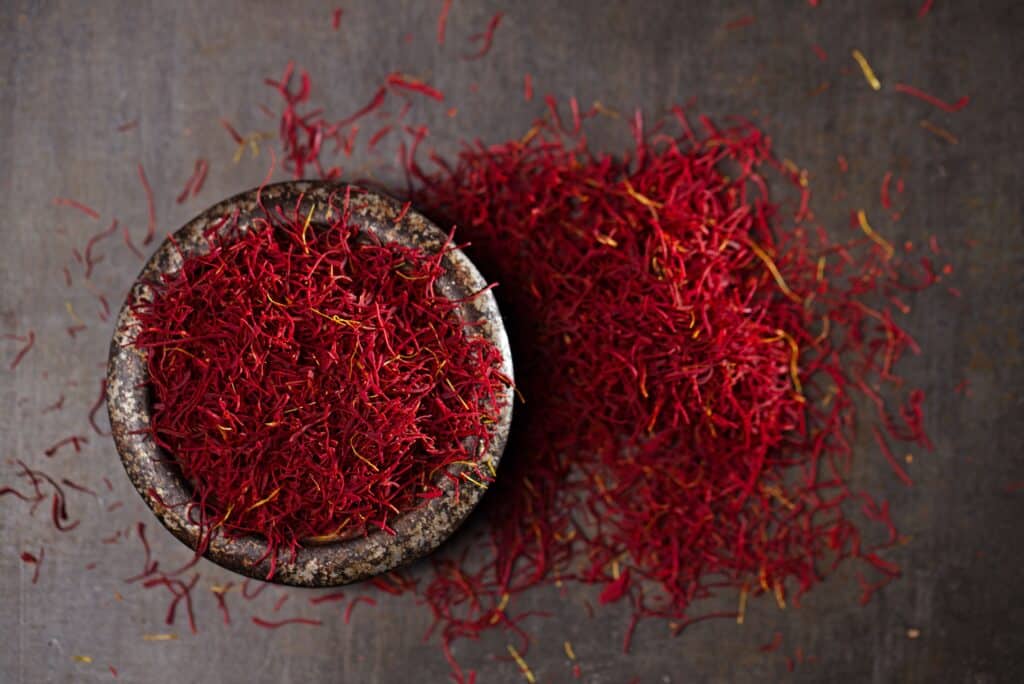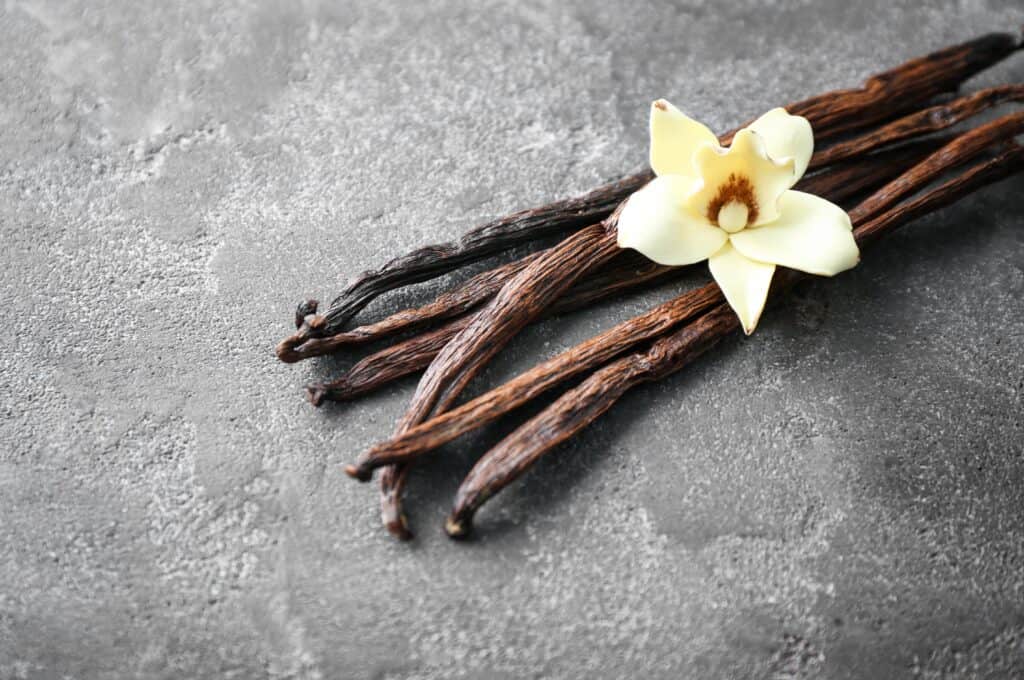Updated On: April 07, 2024 by Ahmed Samir
Spices and herbs have played a significant role in human civilisation for centuries, not only for their ability to enhance the flavours of food but also for their potential health benefits. However, the allure of these precious botanicals lies in their scarcity and price and remarkable ability to transform ordinary dishes into extraordinary culinary creations.
Beyond their role as culinary gems, luxury spices and herbs have been cherished for their medicinal properties, aromatic allure, and cultural significance. As a result, these botanical treasures have been sought after, treasured, and even fought over, shaping history, trade, and exploration. From the ancient spice routes that connected civilisations to the luxury spice bazaars of the Middle East, the stories woven around these spices and herbs are as captivating as the flavours they impart.
Why Were Spices A Luxury?
Luxury spices and herbs have long captivated the senses, arousing curiosity and delighting the palates of discerning individuals. Their enigmatic allure and undeniable charm have made them coveted treasures throughout history, enchanting civilisations with their intoxicating aromas and flavours. While certain spices and herbs are considered luxurious due to their rarity, cost, and cultural significance, their value extends beyond their status. Spices were considered a luxury for several reasons throughout history:
- Rarity and Geographic Origin: Many valuable spices such as cinnamon, cloves, nutmeg, and pepper were originally grown in specific regions of the world, such as the Spice Islands (present-day Indonesia), India, Sri Lanka, and parts of Africa. These regions were far from Europe, where the demand for spices was high. In addition, the long-distance transportation of spices made them scarce and increased their cost.
- Limited Supply and High Demand: Spices were in high demand for their ability to enhance and preserve food flavour. They were also used for medicinal purposes, fragrance, and religious rituals. The limited supply of these exotic spices led to their high prices, making them accessible only to the wealthy elite.
- Labour-Intensive Cultivation and Harvesting: Spices required specialised cultivation and harvesting techniques, often involving manual labour. For instance, nutmeg was harvested from the fruit of the nutmeg tree, while cinnamon was obtained from the inner bark of specific tree species. The labour-intensive nature of spice production contributed to their high cost.
- Control by Middlemen and Monopolies: In many instances, the spice trade was controlled by mediators, such as Arab and Venetian merchants, who established monopolies and controlled the prices. They would purchase spices at the source and then sell them at exorbitant prices, further adding to their luxury status.
- Symbolism and Prestige: Spices were valued for their taste and the symbolism and prestige associated with their consumption. Possessing and using rare and expensive spices became a status symbol among the wealthy and powerful. They were often used to display wealth and social standing.
- Exploration and Discovery: The Age of Exploration in the 15th and 16th centuries led European nations to seek new trade routes to obtain valuable spices directly from their source. This era saw the rise of spice traders like Vasco da Gama and Christopher Columbus. However, the dangers and risks associated with long sea voyages and the need to navigate unfamiliar territories are added to the cost of spices.
Over time, advancements in technology, changes in trade routes, and increased availability led to a decrease in the price of spices, making them more accessible to the general population. Today, spices are readily available and affordable, but their historical significance as a luxury item remains.
What Are the Most Expensive Spices and Herbs?
The most expensive spices and herbs can vary depending on factors such as rarity, difficulty of cultivation, and demand. Here are the most expensive spices and herbs:
1. Saffron

Saffron is widely considered one of the most expensive spices in the world. It is derived from the saffron crocus flower and requires intensive labour to harvest delicate stigmas by hand. In addition, saffron is expensive because it requires many blooms to make a small amount of the spice, which has a unique flavour, scent, and vivid colour. Depending on the quality and provenance, the cost per gramme might be anywhere from $5 and $30. As a result, saffron is often offered in limited amounts because it’s expensive.
2. Vanilla

Vanilla is another highly prized and costly spice. It comes from the vanilla orchid and requires a lengthy and intricate process of cultivation, hand-pollination, and curing. Factors like weather conditions and susceptibility to diseases make vanilla production challenging. Additionally, fluctuations in supply and demand can drive up its price. The vanilla beans can range from $2 to $20 per bean, depending on the type (Madagascar, Tahitian, Mexican, etc.) and quality. Vanilla extract is typically less expensive, varying from a few dollars to around $20 per ounce.
3. Cardamom

Cardamom is a popular spice in sweet and savoury dishes, known for its strong aroma and flavour. Cardamom pods contain small seeds that are harvested by hand. The labour-intensive process and limited cultivation regions contribute to its high cost. As a result, cardamom is a moderately expensive spice. The price of whole cardamom pods can range from $20 to $100 or more per pound, depending on the variety and quality. Ground cardamom is usually less expensive.
4. Cinnamon

Cinnamon is often used; it belongs to the Cinnamomum genus. The most sought-after variety is Ceylon cinnamon (or true cinnamon), grown primarily in Sri Lanka; it has a sweeter flavour than the cheaper cassia cinnamon. The scarcity and demand for high-quality Ceylon cinnamon can make it relatively expensive. Cinnamon prices can vary depending on the type and quality. Ceylon cinnamon (true cinnamon) tends to be more expensive than cassia cinnamon. Ceylon cinnamon can range from $5 to $15 per ounce or more, while cassia cinnamon is generally less expensive.
5. Truffles

They are highly prized and sought-after fungi known for their distinctive aroma and earthy flavour. Both black and white truffles are considered luxurious culinary ingredients. Truffle hunting is a specialised skill, and truffles grow naturally in specific regions under specific conditions. These factors and their limited shelf life make truffles extremely expensive. As a result, truffles are highly valued and can be extremely expensive. Black truffles are generally more affordable than white truffles. Black truffles can range from $300 to $600 per ounce, while white truffles can reach prices of $2,000 or more per ounce.
6. Kaffir Lime Leaves

: Kaffir lime leaves are commonly used in Southeast Asian cuisine, particularly Thai and Indonesian dishes. These aromatic leaves are hand-picked and have a unique flavour. Due to their limited availability outside of their native regions and the increasing popularity of Southeast Asian cuisine, kaffir lime leaves can be quite expensive. Kaffir lime leaves are less expensive compared to some other spices. Its cost range from $10 to $30 or more for a few ounces, depending on the source and availability. Dried kaffir lime leaves are often more affordable than fresh ones.
The prices of spices and herbs can vary depending on quality, source, availability, and market conditions. Therefore, it’s always best to check with local suppliers or speciality stores for current prices in your area.
Which Country Is the Best for Growing Spice and Herbs?
Several countries are renowned for cultivating spices and herbs due to their favourable climate, soil conditions, and expertise in agriculture. Here are a few countries known for growing a wide range of high-quality spices and herbs:
- India: India has a rich history and heritage of spice cultivation. It is the “Land of Spices” and produces diverse spices such as cardamom, black pepper, turmeric, cinnamon, cloves, and more. Regions like Kerala, Karnataka, and Tamil Nadu are particularly known for their spice production.
- Indonesia: Indonesia is famous for its spice production, especially in the Spice Islands (Maluku Islands). It is a major producer of cloves, nutmeg, mace, and other spices. Sumatra and Java are also known for cultivating spices like cinnamon and pepper.
- Sri Lanka: Sri Lanka, formerly known as Ceylon, is renowned for producing high-quality spices. It is famous for cinnamon (Ceylon cinnamon) and cultivates other spices such as black pepper, cardamom, nutmeg, and cloves.
- Vietnam: Vietnam is a significant player in the spice industry and is famous for producing various spices such as black pepper, cinnamon, star anise, and ginger. The Central Highlands region of Vietnam, including places like Dak Lak and Gia Lai, is mainly known for its pepper cultivation.
- Morocco: Morocco is famous for its production of spices like cumin, coriander, saffron, and turmeric. Moroccan cuisine heavily relies on these spices, and the country has a long history of spice cultivation.
- Ethiopia: Ethiopia is known for its unique and flavourful spices. It produces spices like berbere, a spice blend used in Ethiopian cuisine, and fenugreek, cardamom, and others.
These countries have a long-standing tradition of spice cultivation and are recognised for their expertise in growing and processing high-quality spices and herbs. However, many other regions also contribute significantly to the global spice market.
Are Luxury Spices and Herbs Healthy?
Luxury spices and herbs can enhance health if consumed in moderation. While they may be more expensive or considered high-end, their health benefits are not solely attributed to their luxury status but rather the natural compounds they contain.
The enchantment of luxury spices and herbs extends far beyond their historical legacy. In recent years, scientific research has unravelled the hidden depths of these precious ingredients, unveiling many health benefits that make them even more valuable. This article delves into luxury spices and herbs, exploring their origins, cultural significance, and the scientific evidence supporting their potential health benefits, such as:

- Turmeric: Turmeric contains curcumin, a compound known for its anti-inflammatory and antioxidant properties. It is believed to have potential benefits for reducing inflammation, supporting brain health, and aiding digestion.
- Cinnamon: Cinnamon has been associated with improved blood sugar control, as it may enhance insulin sensitivity. It also possesses antioxidant and anti-inflammatory properties.
- Ginger: Ginger is often used to ease nausea, aid digestion, and reduce inflammation. It contains gingerol, a bioactive compound with potential anti-inflammatory and antioxidant effects.
- Oregano: Oregano is rich in antioxidants and may have antimicrobial properties. It has been investigated for its potential anti-cancer qualities and is frequently used as a seasoning.
- Saffron: Saffron contains several bioactive compounds and antioxidants. It is considered antidepressant, anti-inflammatory, and memory-enhancing properties.
Additionally, it’s worth considering the quality and source of spices and herbs to ensure they are free from contaminants and adulteration. Choosing reputable suppliers and using fresh, high-quality spices can help maximise their potential health benefits; luxury spices and herbs have become revered for their potential to promote well-being and enhance the vitality of both body and mind.
While these spices and herbs can provide health benefits, they must be consumed in a varied and balanced diet. The quantity and frequency of spice consumption depend on individual preferences, dietary needs, and specific health conditions. As with any food or ingredient, moderation is key.
What Is the Cultural Significance of Spices and Herbs?

The cultural significance of spices and herbs is deeply rooted in human history and spans various cultures and civilisations. These botanical treasures have been integral in shaping culinary traditions, religious practices, medicinal rituals, social customs, and even trade routes. Here are a few aspects that highlight the cultural significance of herbs and spices:
- Culinary Traditions: Herbs and spices are fundamental to developing regional and ethnic cuisines. They define the flavour profiles of traditional dishes, add depth and complexity to recipes, and contribute to the unique identity of a culture’s gastronomy. For example, basil is an essential ingredient in Italian cuisine, while coriander and cumin are synonymous with Indian curries.
- Religious and Ritualistic Practices: Many spices and herbs hold spiritual and religious significance. They are used in religious ceremonies, rituals, and offerings to deities. For instance, incense made from aromatic herbs is used in various religious traditions for purification, meditation, and spiritual connection.
- Traditional Medicine and Healing: Herbs and spices have been utilised in traditional medicine systems across cultures for their healing properties. Ancient civilisations developed extensive knowledge about the medicinal benefits of specific herbs and spices, using them to treat ailments, promote wellness, and restore balance in the body.
- Symbolism and Celebration: Certain herbs and spices are associated with symbolism and are used to mark special occasions and celebrations. For instance, saffron’s vibrant colour symbolises prosperity and joy in many cultures, making it a popular ingredient in festive dishes.
- Trade and Exploration: The quest for valuable herbs and spices fuelled exploration and trade routes throughout history. Pursuing these botanical treasures led to the discovery of new lands, the establishment of colonial empires, and the exchange of ideas and cultures across continents. The spice trade played a crucial role in shaping the history of civilisations and global economies.
- Cultural Identity and Heritage: Herbs and spices are often deeply ingrained in a culture’s identity and heritage. They are passed down through generations, preserving traditional recipes and cultural practices. The use of specific herbs and spices can evoke a sense of nostalgia and pride, connecting individuals to their cultural roots.
The cultural significance of herbs and spices lies in their ability to enrich and define a culture’s cuisine, traditions, spirituality, and sense of identity. They embody the essence of cultural heritage and continue to play vital roles in our lives today.
When approached with moderation and mindfulness, luxury spices and herbs can be a healthy addition to one’s diet. However, their high cost and status do not solely define their health benefits; instead, the natural compounds they contain and the centuries-old wisdom of their traditional usage contribute to their potential advantages. Whether it’s the anti-inflammatory properties of turmeric, the blood sugar-regulating effects of cinnamon, or the antioxidant-rich nature of many herbs, luxury spices and herbs can offer unique flavours while providing potential health benefits. Furthermore, embracing these ingredients as part of a varied and balanced diet can enrich our culinary experiences and well-being. Remember, savouring the flavours of luxury spices and herbs can be a delightful journey toward a healthier lifestyle.











